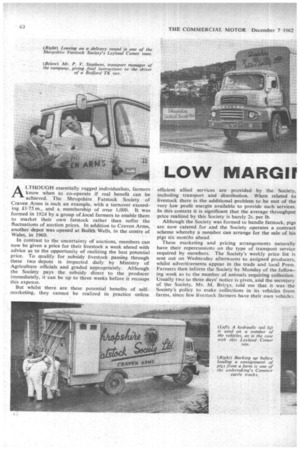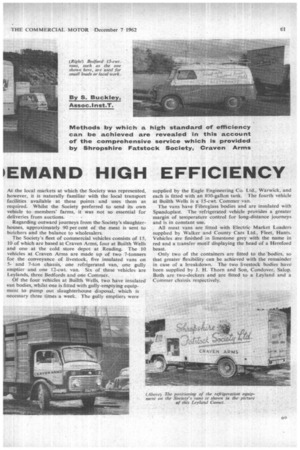LOW MARGIr
Page 62

Page 63

Page 64

If you've noticed an error in this article please click here to report it so we can fix it.
1EMAND HIGH EFFICIENCY
ALTHOUGH essentially rugged individualists, farmers know when to co-operate if real benefit can be achieved. The Shropshire Fatstock Society of Craven. Arms is such an example, with a turnover exceeding £1.75m., and a membership of over 1,000. It was formed in 1924 by a group of Aocal farmers to enable them to market their own fatstock rather than suffer the fluctuations of auction prices. In addition to Craven Arms, another depot was opened at. Builth Wells, in the centre of Wales, in 1960.
In contrast to the uncertainty of auctions, members can now be given a price for their livestock a week ahead with advice as to the opportunity of realizing the best potential price. To qualify for subsidy livestock passing through these two depots is inspected daily by Ministry of Agriculture officials and graded appropriately. Although the Society pays the subsidy direct to the producer immediately, it can be up to three weeks before it recoups this expense.
But whilst There are these potential benefits of selfmarketing, they cannot be realized in practice unless ' efficient allied services are provided by the Society, including transport and distribution. When related to livestock there is the additional problem to be met of the very low profit margin available to provide such services. In this context it is significant that the average throughput price realized by this Society is barely 2s. per lb.
Although the Society was formed to handle fatstock, pigs are now catered for and the Society operates a contract scheme whereby a member can arrange for the sale of his pigs six months ahead.
These marketing and pricing arrangements naturally have their repercussions on the type of transport service required by members. The Society's weekly price list is sent out on Wednesday afternoons to assigned producers, whilst advertisements appear in the trade and local Press. Farmers then inform the Society by Monday of the following week as to the number of animals requiring collection. Usually two to three days' notice is given, and the secretary of the Society, Mr. M. Briggs, told me that it was the Society's policy to make collections in its vehicles from farms, since few livestock farmers have their own vehicles. At the local markets at which the Society was represented, however, it is naturally familiar with the local transport facilities available at these points and uses them as required. Whilst the Society preferred to send its own vehicle to members' farms, it was not so essential for deliveries from auctions.
Regarding outward journeys from the Society's slaughterhouses, approximately 90 per cent of the meat is sent to butchers and the balance to wholesalers.
The Society's fleet of commercial vehicles consists of 15, 10 of which are based at Craven Arms, four at Builth Wells and one at the cold store depot at Reading. The 10 vehicles at Craven Arms are made up of two 7-tonners for the conveyance of livestock, five insulated vans on 5and 7-ton chassis, one refrigerated van, one gully emptier and one 12-cwt. van. Six of these vehicles are Leylands, three Bedfords and one Commer.
Of the four vehicles at Builth Wells, two have insulated van bodies, whilst one is fitted with gully-emptying equipment to pump out slaughterhouse disposal, which is necessary three times a week. The gully empfiers were supplied by the Eagle Engineering Co. Ltd., Warwick, and each is fitted with an 800-gallon tank. The fourth vehicle at Builth Wells is a 15-cwt. Commer van.
The vans have Fibreglass bodies and are insulated with Spandoplast. The refrigerated vehicle provides a greater margin of temperature control for long-distance journeys and is in constant use.
All meat vans are fitted with Electric Market Loaders supplied by Walker and County Cars Ltd., Fleet, Hants. Vehicles are finished in limestone grey with the name in red and a transfer motif displaying the head of a Hereford beast.
Only two of the containers are fitted to the bodies, so that greater flexibility can be achieved with the remainder in case of a breakdown. The two livestock bodies have been supplied by J. H. Thorn and Son, Condover, Salop. Both are two-deckers and are fitted to a Leyland and a Commer chassis respectively. The transport staff consists of 10 drivers and three maintenance men who are also responsible for slaughterhouse maintenance. Rates of pay for drivers are 4s. 7d. an hour for meat vehicles and 4s. 9d. for livestock vehicles, based on a 42-hour week. A pension scheme operates after three months of service, with life insurance equivalent to one year's basic salary. An accident-free driving bonus at the rate of £1 per month is paid, at the staff's request, one week before Christmas. Overalls are provided and are changed daily, with an allocation of six per man.
Mr. P. Stephens, transport manager, who has recently taken over responsibility for the Society's transport, informed me that replacement of chassis was based on a five-year period, although containers in suitable condition might be retained longer or reconditioned.
Regarding the pattern of traffic, livestock is collected within a radius of approximately 40 miles and, on shorter journeys, four trips per day might be achieved. Meat distribution, in contrast, is made as far afield as Manchester, South Wales, Birmingham, London and Portsmouth. As an indication of frequency, one journey per week is maintained in season to London and three to South Wales. These journeys are, of course, in addition to local deliveries.
The quantity delivered continues to increase and, following the construction of a garage at Craven Arms in 1960 to cater for long-distance traffic, the slaughterhouse at Builth Wells has been rebuilt this year to cope with a throughput three times greater than the previous year. With the establishment of the Builth Wells depot, a further extension of the area of distribution is anticipated.
While the majority of journeys are undertaken during the day, the Portsmouth delivery is made overnight on a trunk service, so making it possible for meat from livestock killed the previous day at Craven Arms to be in south coast shops on the following day.
Vehicle mileage averages around 900 miles a week and vehicles are brought in for service at 4,000-mile intervals. The Leylands are fitted with automatic chassis lubrication.
Whether meat is destined direct to a retail butcher, wholesaler or the Society's own depots at Builth Wells or Reading, it is nevertheless charged out in a similar manner and the cost of delivery has to bear the appropriate cost of the Society's administrative expenditure.
It is not the Society's policy to hire or rent vans, although local hauliers with whom it is well acquainted are employed for local delivery. The recording system has been revised and vehicle history books are now kept in which are recorded all maintenance and operational data.
Monthly accounts are kept, so permitting frequent comparisons of current operational expenditure. Due to the low margin in the meat trade, such records must be particularly accurate. The current cost of operating the 7-tonners on meat delivery is 18.50d. a mile. Spares worth roughly £800 are kept at Craven Arms.
Current fuel-consumption figure of the Leyland Comets is 15.2 m.p.g. when fitted with insulated vans and 11.2 m.p.g. with the refrigerated van.
Indicative of the throughput at Craven Arms during four weeks in August this year, 12,897 animals were brought in with a weekly average of 3,224. Of this quantity, approximately two-thirds were collected with the Society's own vehicles, rising to approximately 90 per cent for the resulting outward deliveries of meat.




























































































































